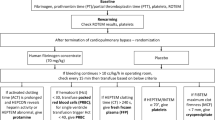Abstract
This prospective, single-centre cohort study aimed to evaluate plasmin generation and fibrinolysis during and after cardiopulmonary bypass (CPB) surgery in a cohort of children up to 6 years of age. Blood samples were drawn at eight time points: after induction of anesthesia, before unfractionated heparin (UFH), after UFH, after initiation of bypass, before protamine, after protamine, after chest closure, and 6 h after chest closure. The study identified an increase in fibrinolysis during CPB and particularly up to 6 h afterward in children. This could be the mechanism for the significant bleeding events observed in this young population after CPB. This study establishes the foundation for future studies in this area, particularly those focusing on clinical outcomes after CPB surgery.





Similar content being viewed by others
References
Andrew M, Paes B, Johnston M (1990) Development of the hemostatic system in the neonate and young infant. Blood 12:95–104
Andrew M, Paes B, Milner R, Johnston M, Mitchell L, Tollefsen DM et al (1987) Development of the human coagulation system in the full-term infant. Blood 70:165–172
Bouma BN, Mosnier LO (2006) Thrombin activatable fibrinolysis inhibitor (TAFI): How does thrombin regulate fibrinolysis? Ann Med 38:378–388
Chan AK, Leaker M, Burrows FA, Williams WG, Gruenwald CE, Whyte L, Adams M, Brooker LA, Adams H, Mitchell L, Andrew M (1997) Coagulation and fibrinolytic profile of paediatric patients undergoing cardiopulmonary bypass. Thromb Haemost 77:270–277
Chandler WL (2005) Effects of hemodilution, blood loss, and consumption on hemostatic factor levels during cardiopulmonary bypass. J Cardiothorac Vasc Anesth 19:459–467
Corrigan JJ Jr, Sleeth JJ, Jeter M, Lox CD (1989) Newborn’s fibrinolytic mechanism: components and plasmin generation. Am J Hematol 32:273–278
Davies LK (1999) Cardiopulmonary bypass in infants and children: How is it different? J Cardiothorac Vasc Anesth 13:330–345
Dietrich W, Dilthey G, Spannagl M, Jochum M, Braun SL, Richter JA (1995) Influence of high-dose aprotinin on anticoagulation, heparin requirement, and celite- and kaolin-activated clotting time in heparin-pretreated patients undergoing open-heart surgery: a double-blind, placebo-controlled study. Anesthesiology 83:679–689
Eisses MJ, Seidel K, Aldea GS, Chandler WL (2004) Reducing hemostatic activation during cardiopulmonary bypass: a combined approach. Anesth Analg 98:1208–1216
Guay J, Rivard GE (1996) Mediastinal bleeding after cardiopulmonary bypass in pediatric patients. Ann Thorac Surg 62:1955–1960
Hunt B, Parratt RN, Segal HC, Sheikh S, Kallis P, Yacoub M (1998) Activation of coagulation and fibrinolysis during cardiothoracic operations. Ann Thorac Surg 65:712–718
Ignjatovic V, Than J, Summerhayes R, Newall F, Horton S, Cochrane A, Monagle P (2011) Hemostatic response in paediatric patients undergoing cardiopulmonary bypass surgery. Ped Cardiol 32(5):621–627
Khuri SF, Valeri CR, Loscalzo J, Weinstein MJ, Birjiniuk V, Healey NA, MacGregor H, Doursounian M, Zolkewitz MA (1995) Heparin causes platelet dysfunction and induces fibrinolysis before cardiopulmonary bypass. Ann Thorac Surg 60:1008–1014
Levi M, Cromheecke ME, de Jonge E, Prins MH, de Mol BJ, Briët E, Buller HR (1999) Pharmacological strategies to decrease excessive blood loss in cardiac surgery: a meta-analysis of clinically relevant endpoints. Lancet 354:1940–1947
Mossinger H, Dietrich W (1998) Activation of hemostasis during cardiopulmonary bypass and pediatric aprotinin dosage. Ann Thorac Surg 65(6 Suppl):S45–S50
Mossinger H, Dietrich W, Braun SL, Jochum M, Meisner H, Richter JA (2003) High-dose aprotinin reduces activation of hemostasis, allogeneic blood requirement, and duration of postoperative ventilation in pediatric cardiac surgery. Ann Thorac Surg 75:430–437
Parmar N, Mitchell LG, Berry LR, Andrew M, Chan AK (2006) The influence of age on in vitro plasmin generation in the presence of fibrin monomer. Acta Haematol 115:141–151
Parmar N, Albisetti M, Berry LR, Chan AK (2006) The fibrinolytic system in newborns and children. Clin Lab 52:115–124
Parmar N, Mitchell LG, Berry LR, Andrew M, Chan AK (2006) The influence of age on in vitro plasmin generation in the presence of fibrin monomer. Acta Haematol 115:141–151
Ray MJ, Marsh NA, Hawson GA (1994) Relationship of fibrinolysis and platelet function to bleeding after cardiopulmonary bypass. Blood Coagul Fibrinolysis 5:679–685
Summerhayes R, Ignjatovic V, Hall M, Monagle P (2007) Age-related reference ranges for TAFI and fibrin monomers in healthy children. J Throm Haemost 5(Suppl 2):P-S-397
Teufelsbauer H, Proidl S, Havel M, Vukovich T (1992) Early activation of hemostasis during cardiopulmonary bypass: evidence for thrombin mediated hyperfibrinolysis. Thromb Haemost 68:250–252
Valen G, Eriksson E, Risberg B, Vaage J (1994) Fibrinolysis during cardiac surgery: release of tissue plasminogen activator in arterial and coronary sinus blood. Eur J Cardiothorac Surg 8:324–330
Williams GD, Bratton SL, Ramamoorthy C (1999) Factors associated with blood loss and blood product transfusions: a multivariate analysis in children after open heart surgery. Anesth Analg 89:57–64
Author information
Authors and Affiliations
Corresponding author
Rights and permissions
About this article
Cite this article
Ignjatovic, V., Chandramouli, A., Than, J. et al. Plasmin Generation and Fibrinolysis in Pediatric Patients Undergoing Cardiopulmonary Bypass Surgery. Pediatr Cardiol 33, 280–285 (2012). https://doi.org/10.1007/s00246-011-0122-6
Received:
Accepted:
Published:
Issue Date:
DOI: https://doi.org/10.1007/s00246-011-0122-6




